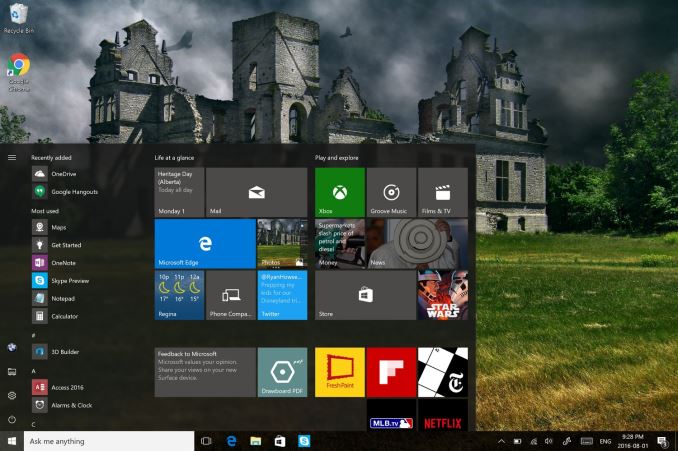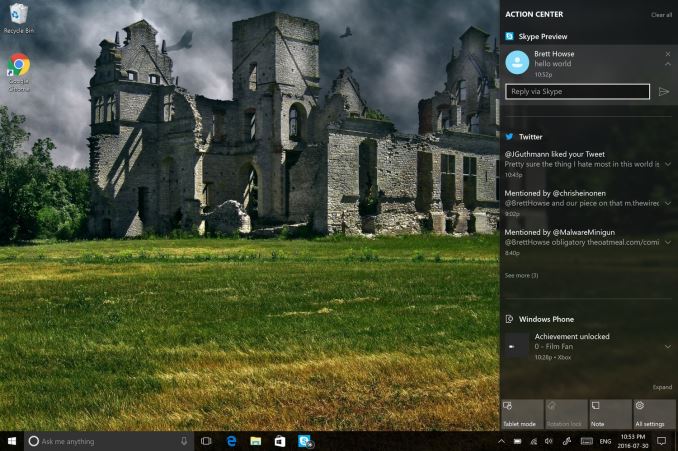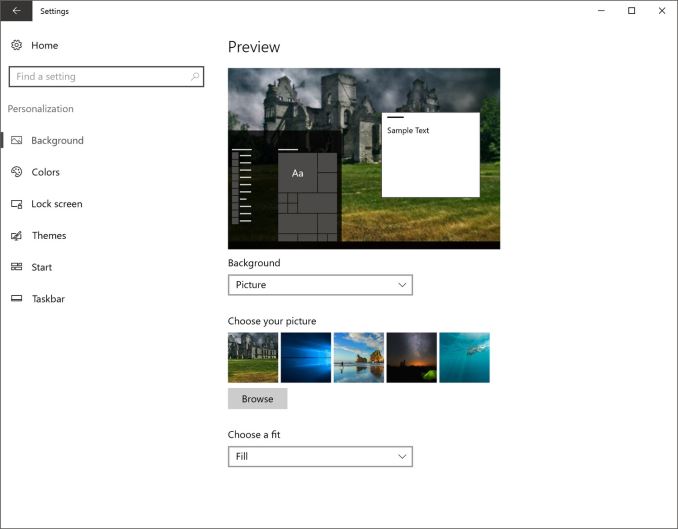Windows 10 Anniversary Update: The Road To Redstone
by Brett Howse on August 2, 2016 8:00 AM EST- Posted in
- Operating Systems
- Microsoft
- Windows 10
Windows 10 Gets Polished
When Windows 10 launched, Microsoft set it up to be “Windows as a Service”. The goal of W10 was for it to be continually updated going forward. In 2015, this is pretty much the default for any new software, which relies on a connected world to always allow constant updates. Windows previous to 10 were patched for security fixes every month, but other than the rare service pack which brought feature updates, what you saw on day one was pretty much what you got when the operating system went out of support. This has changed in a big way with Windows 10. A few months after release, it saw its first feature update to build 1511. This was a small update, but it brought a lot of nice fixes that didn’t make it in time for launch.
The Anniversary Update is an extension of this, bringing a lot of polish to the operating system. Windows 10 didn’t ship in a broken state, but there were certainly a lot of areas where you could see it wasn’t quite done. They’ve made quite a few tweaks for this round, and many of them are quite welcome, while others are purely aesthetic.
Start Menu Changes
The Start Menu has been a work in progress ever since it made its way back to Windows with the Windows 10 launch. Throughout the insider builds, there were quite a few iterations of the start menu, and even with the 1511 update in late 2015, Microsoft updated it to add the ability to add more tiles.
With the Anniversary Update, they are at it again. The biggest change is the 'All Apps' option, which is now gone. All of the apps now default to showing in the Start Menu in a scrollable list, with the most used and recently added apps at the top. The 'Recently Added' option now also shows three apps, which is a nice change. Keeping all of the apps accessible makes it easier to navigate to them. You can of course still just type the name of the app as well, and it will populate from an indexed search.
Action Center Updates
The Action Center gets some nice changes as well. The icon has been subtly tweaked, and it now shows how many notifications you have. The notifications have been increased in size, and Windows 10 now allows you to set priority levels for notifications, so your most important ones are always on top. With apps like Skype, you can reply in-line with the notification, either through the toast pop-up when it first arrives, or later through the Action Center.
Microsoft demoed Universal Dismiss and Notification Mirroring at the Build developer conference, which will allow for notifications dismissed on one device to mirror that dismissal to all devices, and that’s made it into this update. One tip for Windows 10 notifications: if you have an app that spams notifications, you can right click it in the Action Center and turn off notifications for that app. This existed prior to this update as well, but it’s a very handy trick so I figured I’d mention it.
Settings Gets Icons
This is a small change, but Settings was completely text based in Windows 10 until this update. Now, there are icons for each setting. In addition, some of the settings have been broken out a bit better into their own categories.
For example, if you want to join the Windows Insider Program, that has its own category under Update & Security, rather than under and Advanced menu for Updates themselves. Settings continues to offer the search function as well, which makes it much quicker to find any setting.
Lock Screen Changes
The Lock Screen has always been a bit of an odd thing in Windows 10. It’s origins are from the mobile side, where notifications and detailed status updates can be quickly seen when you power on your phone. On a tablet or phone, this is likely more useful than on the desktop, but since Windows 10 is the same OS across all of those devices, the lock screen updates are of course across all devices. The new lock screen now integrates Cortana, and the image on the lock screen is now the same one as the log-in screen, meaning it’s a less jarring experience to unlock the PC. The two images was always a bit odd. These are small changes, but a lot of this update is about making a more consistent experience, so they fit well.













194 Comments
View All Comments
powerarmour - Wednesday, August 3, 2016 - link
Indeed, and likewise nor is it fair to say 'Chrome is a battery hog' when plainly isn't on a Chromebook.BurntMyBacon - Wednesday, August 3, 2016 - link
@powerarmour: "Indeed, and likewise nor is it fair to say 'Chrome is a battery hog' when plainly isn't on a Chromebook."Agreed. It's similar to how Safari is a much different program on MAC OS than it is anywhere else. It almost deserves a different name. Chrome is much different on a Chromebook than Windows. Certainly battery life issue are not the same for every platform and they are working to improve it. For instance, Android for a long time made use of Android browser rather than Chrome by default. While Chrome was a more fully featured browser, it also sucked far more energy to do its job. Now, the difference has depreciated to the point that Chrome is the default browser in newer Nexus devices. That said, android chrome still isn't the equal of the Windows and Linux versions and only the Windows version can be compared to Edge (which was the original topic of discussion here).
Murloc - Wednesday, August 3, 2016 - link
chromebooks are hardly relevant for most users, and the discussion is clearly about windows laptops since it's being compared to edge.nikon133 - Tuesday, August 2, 2016 - link
Also works better with touch, imho. I mostly use Chrome on my desktop and (docked) laptop... but on Surface, it is basically 100% Edge.faizoff - Tuesday, August 2, 2016 - link
As everyone have answered @retrospooty, I have an unbranded 10.1 tablet that has 2 GB RAM with an Intel Atom CPU Z3735F BayTrail-T 1.33GHz. So Edge works great on that but the only thing stopping me from using it was adblock.Even on my desktop Chrome is a memory hog where I find each tab takes about 150-250 mb of RAM and surprisingly recently rediscovered Firefox takes a total of 350 MB with at least 10 tabs open.
So yeah Edge is the fastest among them all in terms of initial load plus browsing but the ads.. the ads kill my experience.
Brett Howse - Tuesday, August 2, 2016 - link
As I said in the article, Edge renders text better than other browsers, especially on a high DPI device like Surface Pro 4 / Surface Book.Alexvrb - Wednesday, August 3, 2016 - link
That's a huge plus too... and that's AFTER the upgrades Google made to Chrome a while back in terms of text rendering. Couple years back Chrome's text rendering at ANY resolution was really mediocre.Socius - Wednesday, August 3, 2016 - link
Edge has the smoothest scrolling of any browser. It's also surprisingly fast, with ad-block enabled. The only downside to it is that there is no 100% popup block feature or addon.Lerianis - Monday, August 15, 2016 - link
Edge is great if you block ads.... especially VIDEO ads that even MSN loves to put 3-5 video ads ON THE SAME PAGE and slow Edge to a crawl.I finally did that in my hosts file for a short period and only rescinded that when websites started going to that blocking you from using their websites if you have adblock enabled.
andrejg - Tuesday, August 23, 2016 - link
I use Edge almost all the time, unless there is app or site, that doesn't support Edge. i found very few that I use besides some pages from bank, that use also external certification via smartcard... or so... Really, i just use Edge as it was installed and only few times i was forced to use IE for compatibility reasons... I have found Fox and Chrome to add only complitations for normal use unless there is something special, that needs that particular browser.